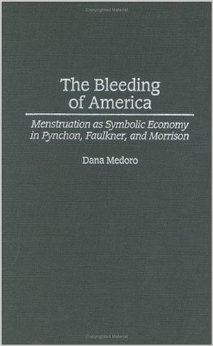 Given their first-hand awareness of the role it has played in their own lives, it is not surprising that women writers (and researchers) have included references to the menstrual cycle in their books. Even so, social taboos have probably tended to keep the subject from appearing as often as it might have otherwise and literary menstrual references have only come to the surface in the mid-twentieth century. The women appearing in the fiction of Bronte, Eliot, Alcott, du Maurier, and the other major women writers of the 19th century seem to be lacking a menstrual cycle regardless of how otherwise thoroughly detailed their lives were depicted.
Given their first-hand awareness of the role it has played in their own lives, it is not surprising that women writers (and researchers) have included references to the menstrual cycle in their books. Even so, social taboos have probably tended to keep the subject from appearing as often as it might have otherwise and literary menstrual references have only come to the surface in the mid-twentieth century. The women appearing in the fiction of Bronte, Eliot, Alcott, du Maurier, and the other major women writers of the 19th century seem to be lacking a menstrual cycle regardless of how otherwise thoroughly detailed their lives were depicted.
Men too have been menstrual-averse. The cycle played no part though later male authors, notably William Faulkner, did include specific menstrual details if only to capture a male chart in the lives of the women in the novels of Hardy, Conrad, James, Dickens, Lawrence or Hawthorne, to name a representative few. Men seem to be “in avoidance,” if not “in denial” about the cycle’s presence. Even male writers such as Updike and Roth for all their frank depictions of sexual behavior have treated menstruation gingerly, in the case of Roth using it in two novels to express characters’ kinkiness.
The more permissive climate of the past 60 or 70 years not only saw the rise of a new generation of women writers, but a greater openness to the inclusion of menstrual material in their stories. Toni Morrison, Joyce Carol Oates, Anne Patchett, and Margaret Atwood, to name a few of the most noteworthy, have built entire scenes or even complete plot lines around menstrual tropes.
This is a subject rich in possibilities for a wide variety of investigations in literary studies, women’s and gender studies, communication and media, sociology, psychology, and even religious studies. With the exception of Dana Medoro’s path breaking book, The Bleeding of America, the subject is virtually untouched. Readers are urged to dig into this treasure trove of material.
So, the purpose of this blog post is to invite suggestions of literary sources that are fertile ground for cycle commentary. Help build the menstrual canon with mention of “sightings” that have come to your attention.


David, I have been intending to write a post about Anne Patchett’s State of Wonder. I had no idea that her most recent novel had a menstrual theme-as it relates to extended female fertility-until I happened to pick it up in the CD Book section to listen to in my car recently. I found myself with a few questions for the author about what I think are some curious omissions in the book. Were they purposeful? If so, what purpose did she think they served? I have the paper copy on hold at the library. I can’t trust my auditory memory to write the post, and I’ll want a quote or two. Stay tuned.
Laura, I’m glad you’re looking into Patchett’s State of Wonder. I’ve been thinking of writing a review of it and would be interested in your take on it. By making the cycle life-long she reverses the fertility identities of men and women and the impact on the cultures. But the fact that she makes the woman scientist a bit of an obsessive and self-centered character makes it more layered. It’s one of the best explorations of the cycle in fiction that I’ve read.
Agreed, David. I was pleasantly surprised, but my biggest issue is that she gave us clear access to the female Brazilian tribe members menstrual cycles, but completely ignored the female scientists’ cycles. It came off to me as mildly racist. They all ate the bark (mostly for malaria prevention than extended fertility presumably, except for Annick) but some had male partners, yet there was no mention of birth control they might have been using. Certainly not hormonal. I found these omissions problematic and unacceptable.
I also though she could have done a better job of explaining how the enhanced fertility worked; the explanation was too facile. I could have provided a better explanation that would have been quite appropriate for fiction. I’ll wager the information about SA birds was more accurate than the information about the menstrual cycle. But I’ll ask my resident bird watcher/biologist for his take on the birds to confirm.
As for Marina, well, more to come in my post. I’m picking up the book at the library this afternoon.
Good point, Laura, regarding the absence of info about the non-Brazilian tribe characters’ birth control practices. That would have enriched the treatment but I hesitate to conclude that it has an underlying racism to it. And I agree that more nuance about how the drug worked to enhance and extent fertility would enhance the story. One of the elements I liked best was that it was essentially about how the big drug companies work and dominate even what it means to be a woman. We’ve already seen that with The Pill and her book extends and demonstrates the ramifications. It would be interesting for us to write reviews contrasting our views for the SMCR journal.